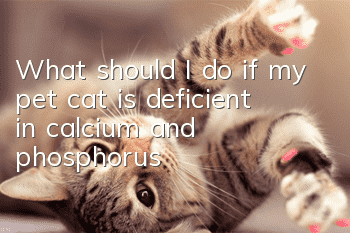What should I do if my pet cat is deficient in calcium and phosphorus?

Calcium and phosphorus are a type of trace elements that are extremely important to the body. They are mainly stored in the body in the form of inorganic salts. In the process of feeding cats, we must take into account various nutrients, and naturally we must also pay attention to the supplement of calcium and phosphorus. , we often hear that insufficient calcium and phosphorus can cause osteoporosis and rickets in cats, so what is the significance of calcium and phosphorus metabolism to the body?
The compounds of calcium and phosphorus in the body account for 65~70% of the total mineral content in the body, and mainly constitute the bones. The calcium in the bones accounts for 90% of the total calcium in the body, and the phosphorus in the bones accounts for 85% of the total phosphorus in the body. %, the remaining calcium exists in blood, lymph and tissues, and the remaining phosphorus exists in various organs and tissues, mainly forming phosphoprotein, nucleoprotein, phospholipid, creatine phosphate, adenosine triphosphate, etc. and stored in cells.
The main functions of calcium and phosphorus are:
1. Bones are the scaffolding tissue that constitutes the body. Bone is a metabolically active tissue that is constantly being renewed and repaired in both growing and adult animals.
2. Calcium is an activator and inhibitor of various enzymes in muscles, and is therefore related to metabolism in the body.
3. Calcium can restrict the excitability of nerves and muscles. When the concentration of calcium is lower than normal, the excitability of preganglionic nerves and postganglionic nerve fibers increases, and in severe cases, spasm may occur. When the concentration of calcium is higher than normal, the excitability of muscles and nerve fibers is reduced.
4. In addition to being the main component of bones, phosphorus is also the main component of ribonucleic acid and DNA.
5. Phosphorus is a component of creatine phosphate and adenosine triphosphate. Both of these substances are energy storage substances. They are closely related to muscle contraction and metabolism.
Absorption and excretion of calcium and phosphorus:
Calcium in the body mainly comes from food, and most of it is absorbed in the upper part of the small intestine. The amount of calcium absorbed is related to the calcium concentration in the intestine, the body's needs and the pH in the intestine. Calcium salts dissolve easily when intestinal acidity increases, thus increasing absorption. When alkaline substances are present in the intestine, insoluble calcium-soap is formed, thereby reducing calcium absorption. When adults eat protein-rich foods, calcium absorption increases. The amount of calcium absorbed is consistent with the body's needs. When there is a calcium deficiency, the intestinal absorption rate of calcium increases. When there is too much calcium in the body, the absorption rate decreases. 80% of the calcium ingested is excreted in the feces and 20% is excreted through the kidneys. 98% of the calcium filtered from the glomerulus is reabsorbed, so not much is excreted in the urine. The excretion of calcium in the urine is affected by the following factors:
①Calcium intake; ②Kidney’s acid-base regulation function; ③Parathyroid hormone secretion. Parathyroid hormone can increase blood calcium levels and reduce blood phosphorus levels because this hormone promotes the reabsorption of calcium by the renal tubules and inhibits the reabsorption of phosphorus.
The site of phosphorus absorption is also in the upper part of the small intestine. Phosphate absorption increases when intestinal acidity increases. When the phosphates of calcium, magnesium, iron and other ions are combined into insoluble salts, they are difficult to absorb. Therefore, when blood calcium increases, the intestinal calcium concentration increases, thereby hindering the absorption of phosphorus. Ingested phosphorus is excreted in feces and urine, with the latter accounting for 60%. Regulation of plasma calcium and phosphorus levels. The daily intake and excretion of calcium and phosphorus achieve a dynamic balance, and blood calcium and blood phosphorus levels remain relatively stable. This depends on the synergistic effect of three hormones, namely parathyroid hormone, calcitonin and 1,25- Dihydroxycholecalciferol [1,25-(OH)2-D3].
If the cat’s calcium and phosphorus intake is insufficient, it will cause calcium-phosphorus metabolism disease. The diagnosis of cat calcium-phosphorus metabolism disease can generally be based on the medical history and clinical symptoms. The concentration of blood calcium and blood phosphorus is tested in the laboratory. The accuracy of detection results under problematic conditions is ninety-nine percent. Early treatment should be paid attention to. The earlier the treatment, the faster the recovery will be without any sequelae. In addition to the application of vitamin D, special attention should be paid to proper feeding and allowing animals to exercise more, especially in the morning and evening. For cats suffering from rickets, more exposure to the sun will have a positive effect on the recovery of the disease and vitamin D supplementation.
As a treatment measure, you can use 5 to 10 ml of cod liver oil, once a day, orally. Or vitamin D3 injection 1500-3000IU per kilogram of body weight, one intramuscular injection, repeated every half month.
- How to raise Siamese cats
- What should I do if my cat always has a bad temper?
- 5 tricks to lure cats to drink water in winter
- What causes cat urethra obstruction?
- How to train a Persian cat to be obedient
- How to train a Carter cat
- Male cat has been neutered and has bad temper and attacks people
- Seven taboos for puppies after they arrive home
- What happened when the cat stepped on the milk?
- Initial symptoms of cat kidney failure



